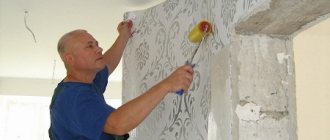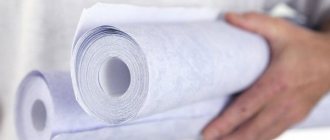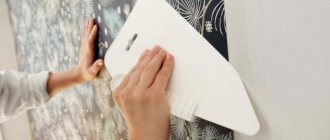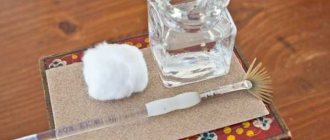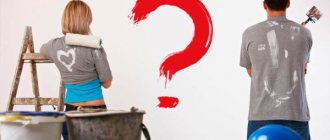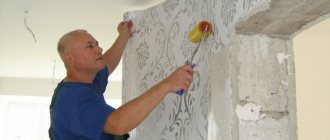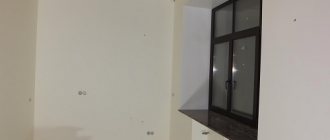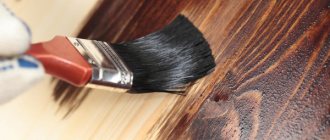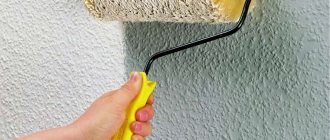Repairs are inevitable if housing is purchased on the secondary market. In new buildings, the walls are clean and there is no thinking about how to work with the old finishing material. In an apartment where people have already lived, the walls can be whitewashed, painted, or wallpapered. The ideal option is when old coatings are removed before plastering. This is especially true if it is wallpaper or oil paint. The whitewash is washed off with water.
Coating with water-based paint raises a number of questions that are best studied before starting repairs: is it possible to glue wallpaper on water-based paint; How is the type of CM that is already covered on the wall recognized?
The principle of determining the type of dye
It is difficult to visually distinguish between oil-based paint and water-based paint. The shine of the coating is the first sign that an oil composition has been applied to the wall. Difficulties arise if the coating is matte. Then it is tested.
The sharp end of the staple is used to pry off the layer of finishing material.
- the coating with oil CM can be easily removed in large pieces;
- The water-based dye is removed along with the putty and sprinkled with fine powder.
The test suggests that water-based paint can be used to glue wallpaper. There is no need to completely remove and scrape off the dye, but the surface of the walls is prepared for gluing the panels.
The test confirmed that the water-based emulsion has good adhesion to plaster or putty, but over time it may peel off. You can often find out about this after wallpapering. They dry and pull off the bottom layer of paint. The quality of the new finish is lost.
Determining the type of paint coating
The composition of water-based paint includes water, one part of which is used to dilute the mass to the desired consistency, the other half is in an aqueous film-forming dispersion. Various emulsifiers, stabilizers, thickeners and corrosion inhibitors are used as additional components, affecting the quality of the final product.
When treating a wall with a paint based on a water dispersion, high-quality and reliable adhesion of the coatings occurs, as a result of which it is difficult to remove paint from the treated surface.
According to building codes, any old finish (even in good condition) must be removed, the surface cleaned and primed. If the water-based material does not contain defects, flaws and does not crumble, gluing the canvases onto a painted wall is allowed, but to do this you need to be sure that the old paint is water-based.
To figure out what kind of paint and varnish material was used previously, you need to take a spatula and clean a small area on the surface.
Wall coverings are most often treated with 2 types of paints:
- Oily.
- Water-based.
Oil enamels are made on the basis of drying oil, are characterized by high wear resistance, water resistance, low film hardness and a specific odor, and are applied in an even, solid layer. Over the years, the surface with oil paint turns yellow and flakes. The water-based substance has no characteristic odor, dries quickly, adheres well, is absorbed into the coating, and has a thinner film.
When examining the type of paint coating, pay attention to the following:
- Old paint is easily scraped off and falls off in layers. This means that the wall is painted with oil enamel, it must be removed, otherwise the sheets will fall off.
- The material does not delaminate during cleaning and is firmly connected to the wall. This means that water-based enamel has been applied to the surface. It is difficult to get rid of it; it requires a lot of time and a soap solution.
In addition, take into account the following: if the paint has been constantly renewed, its layer is too thick (the norm is 2-3 layers), you cannot glue wallpaper. The paintwork is removed from the wall.
Checking the paint coating for durability
Advice from experts on working with an old layer of water-based emulsion:
- Cheap, easy-to-remove water-based coatings are recommended to be washed off completely. It can be removed with water as much as possible. This layer is not strengthened by the adhesive composition.
- If the quality of the paint is high, then it is better to create a solid base and stick wallpaper on it. Another small test is being carried out on the tensile strength of the CM coating. Newspaper is glued to the water-based paint; after it dries, you need to try to remove it. Where this is difficult to do, you can glue wallpaper without fear. If there are many problem areas, then the old finishing layer of paint is removed with hot water.
- As a rule, it is not the strength of the paint itself that is checked, but the layer of plaster and finishing putty underneath it. It is not difficult to wash off the paint. The reliability of the plaster and putty layer is important. Preparatory work will be added if, when removing the CM with water, the putty begins to peel off. A simultaneous check of the old layer of water-based emulsion and the plaster underneath is underway.
Preparatory process
Wallpaper can indeed be glued to water-based paint, but this must be preceded by a full-fledged preparatory process.
Many people want to glue canvases directly onto the paint only because removing the water-based composition from the wall is very problematic. The preparation process includes several main stages.
Formation of a rough surface
The surface, which is painted with water-based paint, is smooth and even, so it is not suitable for gluing canvases. Roughness creation is required. This is done using sandpaper or small scrapers.
With their help, you can remove excess paint and varnish composition and create roughness, thereby improving adhesive characteristics. The treated surface should be washed with soapy water and allowed to dry naturally.
Important! It is necessary to know the approximate thickness of the previously applied paint composition. If the paint was applied in several layers and was constantly renewed, then it is not worth gluing wallpaper on such a surface. Optimally - no more than 2-3 layers of paint and varnish composition.
Primer and putty
Before gluing wallpaper, you can treat the surface with primers. You need to choose a high-quality primer that will adhere well to the paint surface and provide good adhesion for gluing wallpaper.
The best option is to purchase a primer with antiseptic properties (it will provide protection against mold and fungal infections).
If the surface on which you plan to glue the wallpaper has minor chips, cracks and other defects, they can be removed using a putty solution. If there are serious defects on the surface, then you should abandon the idea of gluing wallpaper onto it (it is better to completely remove the paint and apply a new finish to a clean rough surface).
Is it necessary to plaster the wall?
Applying the plaster composition will allow for a high-quality leveling of the rough base. And the finished surface will serve as an excellent base - you can glue textile, paper, vinyl, non-woven wallpaper onto it.
Important! You don’t have to apply plaster if you plan to glue liquid, textured or other types of heavy and thick wallpaper, which themselves can hide minor unevenness in the black base.
Preparatory work on walls covered with water-based emulsion before wallpapering
After testing the strength of the old coating, a method of preparing the walls for gluing is selected:
- the paint is completely washed off from the base;
- without removing the CM, the walls are prepared.
Complete removal of CM
In order to completely wash off the water emulsion you will need: warm water and soft old terry towels. They absorb water well. Towels are soaked generously in water. They wash the walls. The more often the walls are rinsed and wiped, the faster the paint will wash off. If the fabric remains clean after wiping, then the work can be completed. The CM is washed off the wall.
Places where the putty-plaster layer has peeled off need to be repaired. Shallow recesses are puttied, large ones are treated with tile adhesive.
Preparing the wall without removing CM
The existing CM layer is processed with fine-grain sandpaper. Two goals are achieved: the wall is leveled and roughness appears. They improve the tenacity of wallpaper and surfaces. Defects are first sealed, dust is removed with a vacuum cleaner, it is better to wipe everything with a damp cloth. After drying, a deep penetration primer is applied to the wall using a wide brush or roller. After 4 hours, additional treatment is carried out: a mixture of primer and wallpaper glue is applied (component ratio 1:1). Allow 24 hours for final drying.
The wet base is not covered with wallpaper. A simple way to check the degree of dryness. A small cellophane is fixed on it with tape for the whole night. There should be no drops of moisture under it in the morning. If the situation is the opposite, then you need to wait another 24 hours.
Dry walls are ready for wallpapering.
How to properly prepare walls
Before we start looking at the workflow, I will list the cases when paint must be removed:
- If the composition does not adhere well to the surface;
- The layer is covered with numerous small cracks;
- There are pockets of mold on the surface.
That is, you can work with a painted base only if the layer holds firmly and does not lag behind the base.
The paint must adhere firmly
To check the strength of the paint layer, use regular tape. Glue a small piece onto the surface and then tear it off. If there are no traces of paint on the adhesive layer, then the base is suitable for wallpapering.
Stage 1 – surface preparation
To begin, stock up on the necessary materials, the list of which is indicated in the table.
Non-woven wallpaper is best suited for painted walls
| Material | Recommendations for selection |
| Wallpaper | From practice I can say that it is best to glue non-woven wallpaper. They are not as heavy as vinyl and much more durable than paper. |
| Primer | Standard acrylic-based deep penetration compositions are what you need. You can purchase both ready-made compositions and a concentrate, which is diluted with water before use. For dark walls, it is better to use a composition with pigment or add 30% water-based paint to the soil |
| putty | Used if there is damage on the surface that needs to be repaired |
| Wallpaper glue | Selected according to the type of wallpaper. You should not skimp on the quality of the composition; a low price most often indicates low performance |
One of the highest quality glue brands is Methylane.
Is it possible to hang wallpaper over water-based paint without prior preparation? Definitely not, in order for the coating to hold up well, you should do the following work:
The scheme of work is very simple
- First of all, you need to ensure unobstructed access to painted surfaces. The furniture is moved to the center and covered with polyethylene to prevent dust from falling on the surface. The bases are cleaned using a brush or vacuum cleaner. If there are stains on the walls or ceiling, they must be removed with suitable compounds;
Difficult stains are removed with special compounds
- The surface is carefully inspected; if there are areas with peeling coating, then they need to be thoroughly cleaned. It is also worth paying attention to all damage and cracks in the putty. If there are any, then you need to remove all unreliable areas ;
- All irregularities and damage are repaired with putty. It is best to use the Vetonit composition, but any other option will do. It is necessary to fill the damage and level the surface with a spatula;
All irregularities are carefully repaired
- After the putty has dried, you need to finally level the surface. To do this, use a grater with sandpaper or an abrasive mesh with a fine grain (P180 or less). It is necessary to grind not only the repair areas, but also the rest of the surface. This is necessary to eliminate minor flaws and improve the adhesion of glue and primer;
You need to carefully process the entire wall area
- After grinding, the surface must be cleaned of dust. You can brush it, or you can use a vacuum cleaner;
- Before gluing wallpaper on water-based paint, you should treat the surface with a deep penetration primer. The work is done using a roller or wide brush, the composition is evenly distributed over the surface. After the first layer has dried, apply the second, and the direction of application should be perpendicular, this way you will ensure the best quality of processing.
The primer strengthens the surface and improves glue adhesion
If your walls are dark in color and your wallpaper is light, then it is better for you to use a primer with a color pigment for the job. It not only strengthens the surface, but also paints it white.
Light and dark walls are prepared using different compositions
Stage 2 – wallpapering
Let's figure out how to hang wallpaper on water-based paint with your own hands:
- First of all, prepare the workplace. You must decide where you will place the wallpaper when applying the glue. There should also be a tool at hand for applying glue, cutting material and smoothing the surface;
Before gluing the wallpaper, do not forget to purchase a tool for the job.
- To ensure that you glue the sheets evenly, you need to mark them on the wall in advance. For this, it is best to use a cord with a plumb line. With its help, making a vertical line will not be difficult; you need to mark the walls according to the width of the canvases. The process takes a little time, but greatly simplifies the work and guarantees the ideal placement of the wallpaper;
A plumb line is a simple but very accurate device for drawing vertical lines.
- The distance from floor to ceiling is measured and the wallpaper is cut into sheets of the required size. Don't forget to leave a margin of 2-3 cm on each side to avoid any unpleasant surprises when gluing . If the plinth is already fixed, then measurements are taken from its edge, and not from the floor and ceiling;
If the wallpaper has a pattern or design, then when cutting the elements, do not forget to join them first. It is very important to combine sheets correctly so that there is as little waste as possible. Sometimes it’s easier to use different rolls than to cut off an extra meter in one.
It is very important to combine drawings correctly
- Preparing glue is a simple process. The instructions on the package will tell you the proportions of the components and the process of mixing them. Most often, the composition needs time to swell, so read the information on the label and do the work in advance so that the glue is ready by the time the process begins;
Most formulations must sit before use.
- The glue is applied to the canvas with a special brush or roller. It is worth distributing the composition evenly, paying special attention to the edges . The canvas is folded as shown in the photo below and left for about 5 minutes to saturate the base;
This is how you can fold canvases so that they are soaked and the front side does not get dirty
- If the wallpaper manufacturer recommends applying glue to the wall, then while the wallpaper is soaking, you need to carry out this part of the work. The composition is distributed generously, but without smudges, so as not to remove excess from the edges later. There is no need to save at this stage and think whether the wallpaper will stick securely or will begin to come off in six months;
Wallpaper glue does not need to be applied in a very thick layer.
- Wallpapering with water-based paint is done according to the standard scheme. It is better to work together, one person begins to glue the sheet on top, aligning it along the line. Next, the one who is below opens the lower part and gently presses it along the marks. While the glue is fresh, the canvas moves well, so all major edits are made immediately;
It’s much more convenient to work together
- The next stage is leveling the surface and removing excess glue and air bubbles. For work, use a special spatula or wide brush . The work is done in the direction from the middle of the canvas to the edges. You need to go in order from top to bottom and try not to miss a single section. The easiest way to remove excess glue is with a rag;
It is very important to remove all the air from under the wallpaper
- Let's figure out how to glue the next sheet. The work is done in a similar order, with the only difference being that you need to combine a drawing or pattern. The most important thing here is accuracy and attentiveness, expose the canvases while the glue is fresh, then you won’t be able to do it. And do not forget to ensure that the joint is smooth and tight;
The joints are the most noticeable part of the wallpaper, combine the sheets as accurately as possible
- After several sheets have been glued, you can cut off the excess at the top and bottom. For this job, it is best to use a construction knife. The blade is carefully guided along the joint, after which the excess is removed. If you have a fixed baseboard, you can cut using a spatula to make the line perfectly accurate and even;
Excess can be easily cut off with a wallpaper knife
- During the drying process, do not open the windows. The process takes about a day, after which the surfaces are ready for use.
If you need to prepare the surface for liquid wallpaper, then the process is carried out in exactly the same way. Therefore, this review is also suitable for those who will apply a decorative coating to a painted surface.
The surface for liquid wallpaper is prepared in the same way as for traditional wallpaper.
Conditions for choosing wallpaper for walls with water-based emulsion
Craftsmen do not recommend gluing heavy wallpaper - vinyl panels. They are thick and even special glue will not be able to hold them on a wall previously painted with water-based paint. Non-woven, liquid wallpaper is recommended. The price of paper for a 10 m roll with a width of 0.53 m starts from 345.00 rubles and reaches 1000.00 rubles. The base under them is leveled, stains and uneven coloring are removed. It is better not to purchase wallpaper of different thicknesses. The glue underneath dries at different times, which negatively affects the water-based coating. It is recommended to prepare special bases for this type of panel. They come in two types in rolls: paper base and non-woven material made from modified cellulose. The second type of base is more durable. Under paper and non-woven wallpaper, the adhesive base dries quickly. A non-woven roll of 10 m with a width of 0.53 m costs an average of 1300-1600 rubles.
Liquid wallpaper holds on more tightly than others. The average price per package is from 300 to 1000 rubles, depending on the brand. Packaging consumption per 1 m2 is an average of 3.5-5 m2. In addition, they apply easily to paint and hide surface defects.
But the best option remains non-woven panels for covering walls painted with water-based paint. This is a high quality finishing material, light in weight, with high performance qualities.
When the canvas is already glued, it is not recommended to press it to remove bubbles. They are driven out with a thick roller or a plastic spatula with a rubber tip. If the strip is often torn off, the grip is reduced.
Priming the water-based layer
A water-based emulsion with weak water-repellent properties will peel off if it is over-wetted with glue. The dye will get wet and, along with the new finish, will slide off the wall.
The base is strengthened with a primer. In addition, the adhesion of paintwork materials and the adhesive mixture improves. Fine quartz is introduced into the primer. The astringent components of the primer composition secure it to the base painted with emulsion. The glue clings to the grainy primer surface. In the primer, adhesive elements glue microcracks on the treated wall, thereby strengthening weak areas of the surface. Only after such treatment will it withstand the weight of the glued canvases.
The surface is cleaned of dust and dirt before applying a strengthening primer. The coating is carried out in 2 layers. Each subsequent one is applied to the dried previous one. Manufacturers indicate on the container the time for the coating layer to completely dry. The duration is also affected by air temperature and humidity. A primer composition is selected that interacts with the concrete base. It is recommended to use a white primer, then it will not bleed through the glued panels.
Choosing the right wallpaper
An important step when deciding to stick wallpaper on water-based paint is the correct choice of material.
Wallpaper differs in type and thickness, which in turn requires applying different amounts of glue. If a lot of glue is required and the adhesive takes a long time to dry, this can lead to swelling and soaking of the water-based paint under the wallpaper.
- Single-layer paper wallpaper can be used for gluing. They are light in weight and allow the glue to dry quickly.
- Non-woven wallpaper on a paper or vinyl basis can be glued only after preliminary preparation of the surface.
- Washable and thick vinyl wallpaper is not recommended for painted surfaces. They are heavy and take a long time to dry. If adhesion to the surface is poor, they may fall off over time.
- Liquid wallpaper will stick well to a water-based paint composition. They have high strength, and are also able to hide existing unevenness or defects in the walls.
Wallpaper glue
The work can be done efficiently and quickly if you purchase glue for the type of wallpaper.
Experts recommend:
- adhesive composition from the French company Kleo (for non-woven fabric the price is 867.00 rubles per 1 kg. A package of 260 grams is diluted with 6.0 liters of liquid glue, which is used to cover a 30 m2 area), the second option is Quelid (the price depends on the type of wallpaper. For non-woven wallpaper price 309.00 rubles per pack of 300.0 grams. Enough for gluing 4 rolls);
- CMC, proven over the years (price 50-200 rubles). If PVA is introduced into the composition, then the leadership of the mixture in terms of strength is undeniable.
Required materials and tools
- Wallpaper. Thin non-woven wallpaper is recommended; it is easier to glue and join. They are thinner and lighter than vinyl and stronger than paper.
- Primer. It is better to choose a deep-penetrating water-based primer. Already diluted soil in a purchased container or concentrated soil that requires preliminary dilution is suitable.
- Putty mixture for eliminating wall defects.
- Glue. The choice depends on the base of the paintings.
- Rollers for smoothing wallpaper and joints.
- Metal and wallpaper spatula, stationery knife, brush.
- Clean oilcloth.
- Bucket, access to water.
- Level, plumb.
Methylane is a good glue. The product line includes compositions for all types of wallpaper.
Necessary equipment
This type of repair implies the presence of:
- tassels,
- roller (for applying glue, removing bubbles),
- stationery knife,
- scissors,
- pencil.
Some types of wallpaper must be cut with an allowance for alignment. If the drawing needs to be adjusted, then the necessary pieces must be cut off as work progresses. It should be trimmed along the bottom; it is better to remove excess with a stationery knife. The glue can be applied with a roller or brush.
If the paint turns out to be oil-based
A low-quality, poorly adhering layer of such coating is removed in the most appropriate way. Oil-based paint is more difficult to remove from a wall than water-based paint. Methods for removing different types of old paint are described in detail here.
A durable old oil-based coating is covered with wallpaper after preparation: to increase adhesion, the wall is rubbed with coarse sandpaper and then covered with a layer of primer. On such a surface the wallpaper will stick firmly and for a long time.
Painting wallpaper with water-based paint
We glue the wallpaper ourselves
If in the future you plan to paint the trellises, then you should know that paper and vinyl canvases are simply not suitable for such purposes. Due to their characteristics and properties, paper trellises do not like wet rooms and the influence of water.
Let's look at some tips from experts:
- Select a mixture to paint the walls based on the operating conditions of the room. It is best to immediately use paints that are protected from mechanical influences and are not afraid of water
- The pigment should not be added immediately, but gradually. While doing this, stir the solution constantly. These steps will help control color saturation.
- You can dilute too thick paint with water, but do not overdo it, as this will not harm the basic properties of the paint.
- Many craftsmen like to use paintable wallpaper that initially already has a color and can be painted 3-4 years after the start of use.
Recommendations for gluing
There are several basic recommendations, the study of which will allow you to better glue wallpaper onto water-based paint.
The main ones are:
- If you need to straighten crookedly glued strips, this can be done with a clean rag until the glue hardens. The canvases can be moved slightly to the side until the adhesive has time to set.
- Before gluing the wallpaper, you can use a building level, a ruler and a pencil to mark the room. This will allow you to glue the cut strips faster and more accurately.
- If you intend to glue non-woven fabrics, it is strongly recommended to treat not only the cut strips with an adhesive composition, but also the surface of the wall.
- If bubbles form under the glued strips during gluing, you can remove them from under the material using a rubberized roller or a plastic spatula (you can also use a regular rag).
- During gluing and upon completion of all work, you should not open the windows, turn on the fan or run the air conditioner - all this will negatively affect the quality of the work performed, or even lead to the fact that after a few days the canvases will simply come off.
- It is not recommended to cover painted walls with heavy types of wallpaper. They will require a fairly thick layer of glue to be applied, which will place a large load on the paint, which can lead to its destruction and peeling. Heavy wallpaper glued directly onto a water-based paint and varnish composition is not guaranteed to last long (even if all the necessary preparatory work is completed).
Stages of wallpapering
In order for the wallpaper to fit well and stay firmly in place, you need to correctly complete all stages of the repair.
Assessment of coating quality
If the likelihood of poor adhesion of the paint to the wall is high, it is necessary to remove this area, since subsequently there is a possibility of the wallpaper coming off under the weight of the glue with stuck pieces of paint. Any chips or swelling should alert you - it is better to get rid of such areas in advance. Maintaining the appearance indicates that you can begin finishing the surface.
Wet surface treatment
If washing off water-based paint is unavoidable, it is better to do it efficiently, possibly using soap. The final stage of wall washing is to use clean water without additives. After washing, it is necessary to apply primer, but the walls must dry thoroughly before doing this.
Leveling the surface
This stage is necessary if the walls have a bumpy surface or other pronounced irregularities. The wall will need to be leveled with putty, and a special mesh will be applied to the treated areas, which will adhere the solution and prevent further deformation of the wallpaper. Sanding will ensure good adhesion of the paper to the surface.
Primer coating
When choosing a primer, you must rely on its technical characteristics. The soil should get along well with the concrete, preferably a light shade. Apply it in several layers. It should be taken into account that the resulting wall color should not show through the wallpaper.
Pasting
Before proceeding to pasting, you need to read the instructions for the wallpaper itself. Manufacturers provide comprehensive information with detailed recommendations for wallpapering, how long it will take to dry, how to apply glue, whether or not to adjust the design. To improve the quality and service life, it is worth laying a special tape at the joints, which will provide additional adhesion to the seam.
Operating procedure:
- Cut off the desired piece of wallpaper and lay it out with the pattern down in a clean place.
- Using vigorous movements, apply glue to the entire surface of the back, painting every millimeter, paying special attention to the edges. It is important not to overdo it with the adhesive composition. It should be applied from the center to the periphery.
- In order for the outside to remain beautiful, it is necessary to prevent glue from getting on it.
- It is important to let the wallpaper soak in the glue. To do this, just fold the smeared area like an accordion and leave it in the smeared state for several minutes.
- You should start from the window, carefully tracking the correct location of the pattern.
Gluing process
Instructions for gluing wallpaper:
- Using a measuring tool, lines are laid on the wall that will help to correctly place individual fragments. This is much more reliable than gluing by eye.
- Pieces of wallpaper are cut to the required size. For insurance, it is better to leave a small margin of 2–3 cm.
If there is a pattern, careful cutting of the roll is required. It is often more profitable to cut off the necessary fragment from a new tube than to cut out and throw away significant pieces from the old one.
- Wallpaper glue is prepared according to the seller's recommendations indicated on the package.
- The glue is evenly applied to the fragment using a roller or brush. When gluing non-woven wallpaper, which is most preferable for this case, the wall is also covered with the adhesive, avoiding drops or smudges. The process of gluing vinyl on paper is described here.
- The piece is carefully applied to the marks on the base and smoothed with a rubber roller, a special spatula or a cloth in the direction from the center to the edges. This removes folds and expels air from under the surface of the wallpaper.
When creating a coating that has a general pattern and consists of individual stripes, an important point is the high-quality installation of the first fragment. Its oblique location will entail distortion of the rest, which is difficult or almost impossible to correct.
- Similarly, adjusting the pattern, the following strips are glued. To make the joints stand out less, it is better to start the process from the window.
- After the wallpaper has dried, remove excess with a painting knife. It will be easier to do this on a plinth or baguette.
A high-quality result is impossible without creating an appropriate microclimate in the room: drafts are eliminated for the entire duration of the process and the temperature is ensured around +18 °C. At higher temperatures, the wallpaper may sag; at lower temperatures, it will not dry well.
It will be easier to identify surface flaws during the pasting process if you provide lighting in the room from several sources so that the rays fall on the wall at an acute angle.
Will the wallpaper stick to the “water emulsion”?
It is permissible to glue new finishing material directly onto old paint, but only under certain conditions, the main one of which is the strength of the paint coating.
Let's consider cases when it is necessary to remove paint from walls:
- If it does not adhere well to the surface, it peels off in large fragments.
Sometimes it is difficult to visually determine how firmly the painted layer adheres. You can check it with tape: a piece of it is glued to the wall and then torn off. The absence of paint particles on the tape is an indicator of the strength of the coating.
- The surface of the paint was covered with a network of small cracks and chips.
- There are pockets of mold or mildew on the wall.
In all other cases, applying wallpaper to water-based or oil-based paint is possible with appropriate preliminary preparation.
Is it possible to glue wallpaper on water-dispersion paint?
Wallpaper can be glued to water-dispersion paint only after making sure that it adheres securely to the wall. After checking the adhesion strength of the wallpaper and the wall, you can begin to do the work.
You don’t always want to paint the walls again, and peeling off the paint to stick wallpaper is also a hassle. Therefore, many take risks by trying to glue wallpaper directly onto paint.
This is incorrect, since in order for the wallpaper to stick, it is necessary to pre-clean the walls and treat them with primer and other materials.
If it is not possible to carry out the operation of gluing the wallpaper correctly, it is better not to waste too much time and just immediately paint the walls a different color of paint. Painting will take less time. If this option is not suitable, then when gluing wallpaper you should adhere to certain tips and rules.
Technology for gluing wallpaper onto water-based paint
Before wallpapering, you don’t have to remove the paint layer if 2 conditions are met:
- with firm confidence in its strength and quality;
- with strict adherence to technology during preparatory work.
Disadvantages of walls painted with dispersion dyes may become apparent during the preparation process. Thus, when applying a primer, which is a mandatory step, peeling of the surface or the appearance of blisters may occur. In this case, removal of the old finish is necessary.
Good to know
A few secrets from the masters will help you cope with difficulties at work:
- You can straighten the slanted sheets using a clean cloth. While the glue is wet, the paper must be carefully moved in the desired direction.
- If your eye is not good enough, you can use a pencil and a ruler to mark the location of the canvas.
- When working with non-woven wallpaper, you will have to cover the canvas and walls with glue.
- The resulting bubbles can be removed with a roller or spatula with a rubber tip.
- When carrying out repair work in the cold season, it is necessary to turn off the heating, as it dries out the air and glue.
- Drafts cause damage. It is best to work indoors.
- To reduce the visibility of the seam, the room is pasted in the direction away from the window.
- Sockets and switches are removed before pasting, but the location is marked. In the future, you can remove the excess with a stationery knife and carefully insert them back.
- The ideal air temperature for drying the glue is +18 °C.
- If there is an arch in the room, then you need to allow a supply of wallpaper equal to the width of the arch in order to paste the excess onto this area.
For a high-quality result, it is important to remove all paint on the walls. If the previously applied water-based paint still holds well, which must be verified before the gluing process, you can immediately proceed to renewing the walls.
Preparing the walls
Stages of work:
- If necessary, uneven areas and cracks are cleaned and smoothed with putty.
- The entire surface is rubbed using fine sandpaper or an abrasive mesh. This will increase the adhesion of the smooth coating.
- The walls are freed from dust. You can use a brush, but a vacuum cleaner is better.
- A deep penetration primer is applied. This operation must be repeated at least twice, and in perpendicular directions. The second time is primed only after the first layer has completely dried.
USEFUL INFORMATION: Laying tiles on a plasterboard wall in the bathroom
After such processing, pasting is carried out in a standard way, guided by the rules for the selected type of wallpaper.

